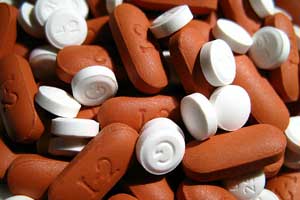Big Pharma was the real winner in last week’s shouting match between Obama and the insuranceindustry. Insurance execs took all the heat for attacking the White House’s health reform plan after the administration and lawmakers had negotiated for months to craft a proposal that the industry could live with. Meanwhile, Pharmaceutical Research and Manufacturers of America (PhRMA), the main industry umbrella group, got to play the good guy—all the while escaping scrutiny for the fact that in recent months it has been quietly jacking up drug prices.
Of course, Big Pharma already stands to hit the jackpot from Obama’s proposed reform plan. Under the deft direction of its chief lobbyist, former Louisiana congressman Billy Tauzin, PhRMA had already secured a valuable deal from the White House to provide a $80 billion in cost savings over the next 10 years in return for the President’s promise to oppose controls on drug pricing and importation of drugs from abroad. As Fox’s Brian Sullivan points out, health reform will increase the market for pharmaceuticals by tens of millions of people—a stock market bonanza:
The top 10 prescription drugs in America do around $40 billion per year in sales. It is estimated that 30 to 40 million Americans… lack insurance, or about 20 percent of the population. These 30 to 40 million new ‘customers’ will have greater access to doctors and prescriptions. …this could add another 20 percent to sales of $40 billion is—bingo—$8 billion per year. And remember that only factors in the top 10 drugs. There are hundreds more in the market. It is clear that $8 billion in cost cuts will be made up in multiples over the years.
But just in case someone throws a wrench into the deal, Big Pharma has been hedging its bets by quietly running up drug prices this year. The Pharmalot blog reports:
During this year’s third quarter, eight of an average 8.7 percent—easily outdistancing the core Consumer Price Index of 1.4 percent, according to a recent research report by Credit Suisse analyst Catherine Arnold.
Who led the pack? Schering-Plough (soon to be bought by Merck) with a 12.8 percent hike, while Abbott imposed a 4.4 increase (Abbott’s price hikes have, in fact, been declining over the past year, the report notes). What about the others? Merck upped the ante by 9.9 percent; Wyeth (soon to be part of Pfizer) drove prices higher by 9.3 percent; Lilly was at 9.1 percent; Bristol-Myers Squibb prices rose 8.9 percent; Johnson & Johnson increased prices by 7.8 percent, and Pfizer prices rose 7 percent.
of its arrangement. But as the Senate Finance Committee moved the legislation last week, the deal seemed to be holding together just fine. Newsweek’s Howard Fineman explains how two attempts to ramp up funds from the drug industry were beaten—not by Republicans, but by Democrats:
The Senate Finance Committee’s bill, which passed out of committee on Tuesday, leans very hard on Medicare—but treads very lightly on the private sector. Sen. Bill Nelson, a Democrat from senior-dominated Florida, apparently had not gotten the memo about leaving Big Pharma alone. He wanted to offer two amendments, each of which would have taken another $100-billion-plus bite out industry’s Medicare revenue. Tauzin was not pleased. Neither was the White House. The senator was talked outof offering one amendment. He narrowly lost on the other after [Jim] Messina, the White House aide, called to express his dismay and to remind everyone that a deal was a deal. Democrats celebrated the outcome as a victory. The only losers were the American people. But, hey, they weren’t at the table.














